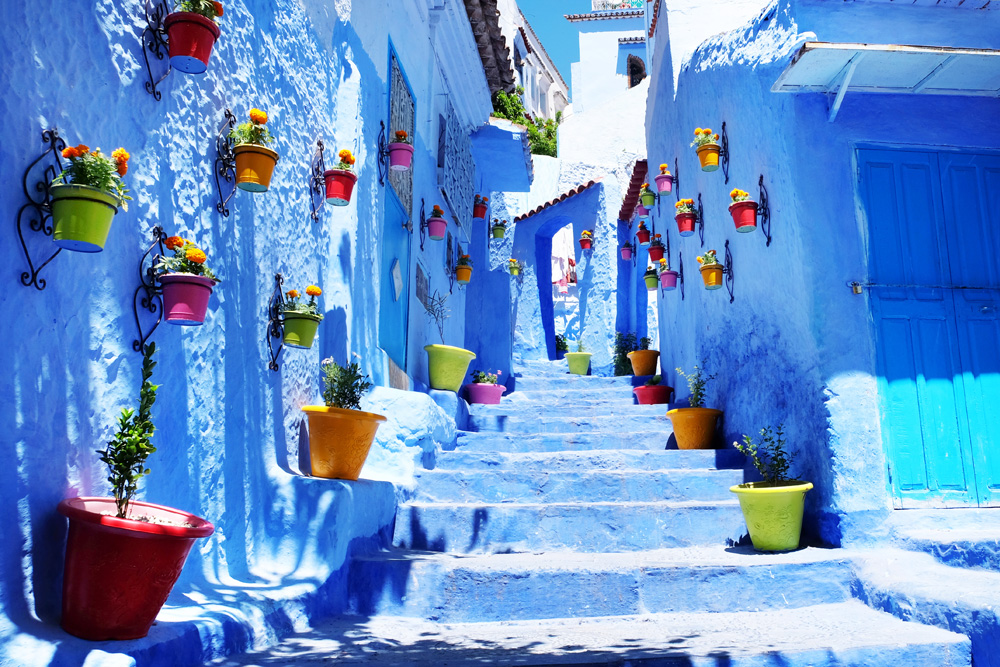
Instagram and Pinterest have definitely helped put Morocco’s Chefchaouen on everyone’s radar. Thanks to the distinctive cerulean buildings, which are often interspersed with sprinklings of white, and the surrounding vistas, it is undoubtedly a photographer’s dream. Here’s what you should know about the prettiest town in northern Morocco, nestled snugly in the Rif Mountains.
The History
Moulay Ali Ben Moussa Ben Rached El Alami, believed to be a descendent of the Prophet Muhammad, peace be upon him, founded Chefchaouen in 1471. Known as Chaouen to Moroccans, the northwestern town, just inland from Tangier, was used for fighting the Portuguese invasion in that region. By 1920, Chefchaouen had fallen into Spanish hands, but was later returned to Morocco after the country became independent in 1956.
Throughout the centuries, the town, which still has Spanish influences, has welcomed people from all religions, and you will still find them co-habiting alongside the Berbers. Descendants of the Spanish who made Chefchaouen a Moorish fortress in the 1400s can also be found living here.
Morocco’s Blue City
The quiet, relaxed and ridiculously pretty town, which gives Santorini a run for its money, is known as the “blue pearl.” And with everything in different shades of blue, ranging from powder blue and cyan to indigo and cobalt, it offers a unique travel experience. Whether it’s on the blue-washed houses and buildings, the narrow, cobbled alleyways, steep steps or the cloudless Moroccan sky, the cerulean hues that change tints from dawn till dusk never fail to captivate visitors.
There are several theories behind why Chefchaouen’s walls were painted blue. While some say it’s because the colour keeps mosquitos away, others believe there’s a religious significance. The hue symbolises the sea and sky, reminding residents of God’s power and encouraging them to lead a spiritual life.
The beautifully constructed Moroccan arches, the colourful rows of souvenirs and the characteristic Berber clothes and woven hats, decked with bright threads, are more reasons tourists find themselves looking around in awe.
For Foodies
For breakfast, perhaps the best thing you can do is go to a chic riad (house with central garden courtyard) with a rooftop terrace that offers amazing views. The bread is baked in a traditional wood-fired oven, while the town is known for its delicious fresh, sweet orange juice. The goat cheese native to the area should also be on every foodies must-try list. When you’re thinking of lunch or dinner, try the signature Chefchaouen tagine. The typical Moroccan-style dish is made with fish, vegetables, ras el hanout and around 30 different spices, served with some fluffy couscous. Plus, you won’t regret sitting and chatting with the locals any time they offer some refreshing and sweet mint tea.
For Adventurers
As it’s perched amid the Rif Mountains, Chefchaouen’s surrounding landscape is simply out of this world, offering lots of picturesque hikes around valleys, gorges and mountain streams. The Cascades d’Akchour, a pair of different sized waterfalls, are a must-visit.
For Shop-A-Holics
Chefchaouen is a popular shopping destination as you can find lots of native handicrafts that are not available elsewhere in Morocco, such as wool garments and hand-woven blankets and shawls. Accessories with Aztec patterns, silver trinkets, brassware for the kitchen and colourfully decorated handmade clay tagine pots also call out to you while you walk by.
For Culture Vultures
There are a number of interesting mosques in Chefchaouen. Including the Grand Mosque in Place Outa el Hammam, the central square in the medina. Another one is dedicated to the patron saint of the Jebalah region, plus there’s a ruined mosque built by the Spanish.
The 15th-century Kasbah that was constructed by the great Moroccan leader, Sultan Moulay Ismail, dominates Outa el Hammam. The restored red walled fortress now houses Musée de Chefchaouen, which displays everything local, from clothes and musical instruments to weapons. There’s also an Andalusian garden and an art gallery. It’s worthwhile climbing to the top as the views from the Kasbah towers are breathtaking.

















